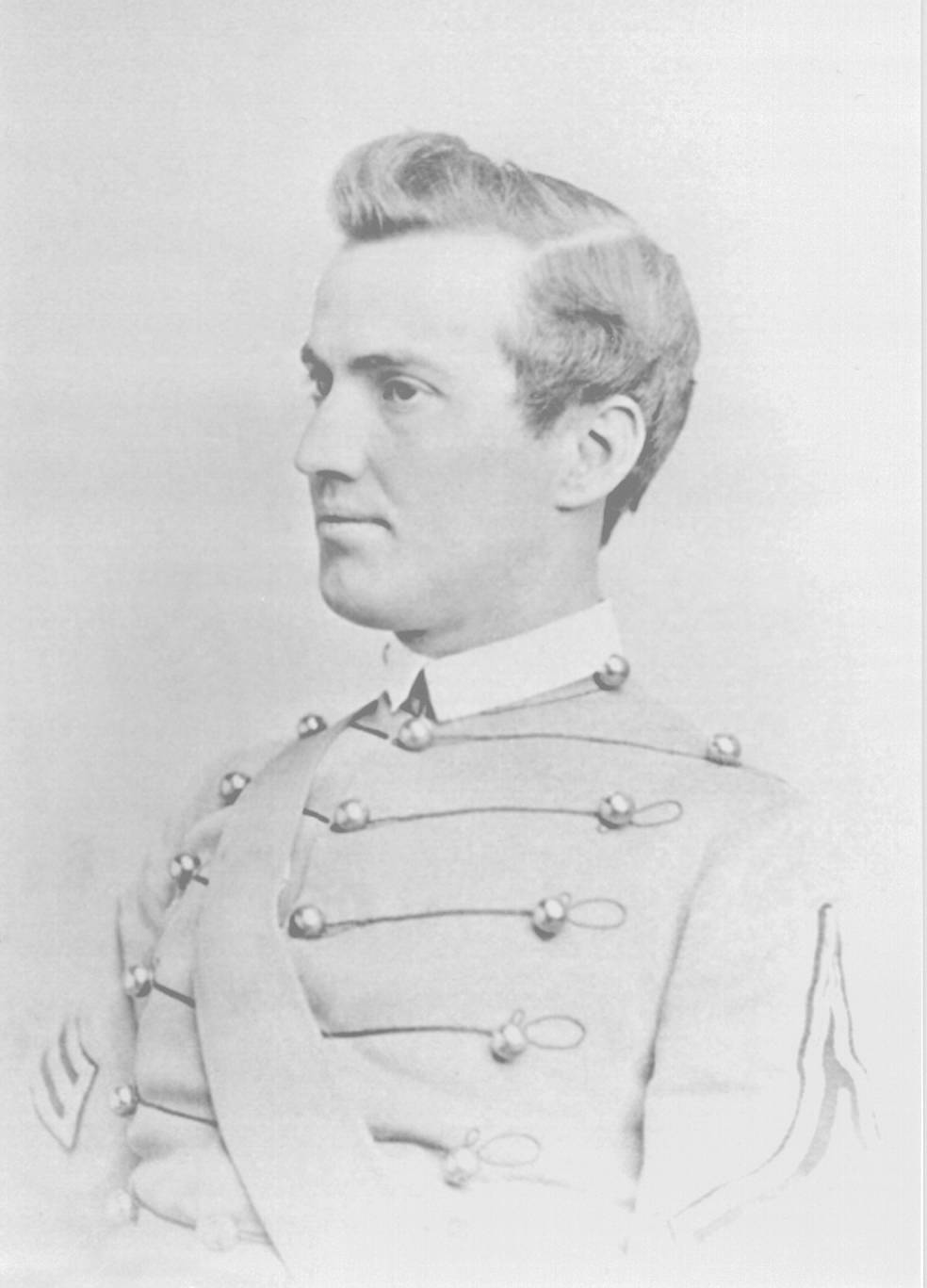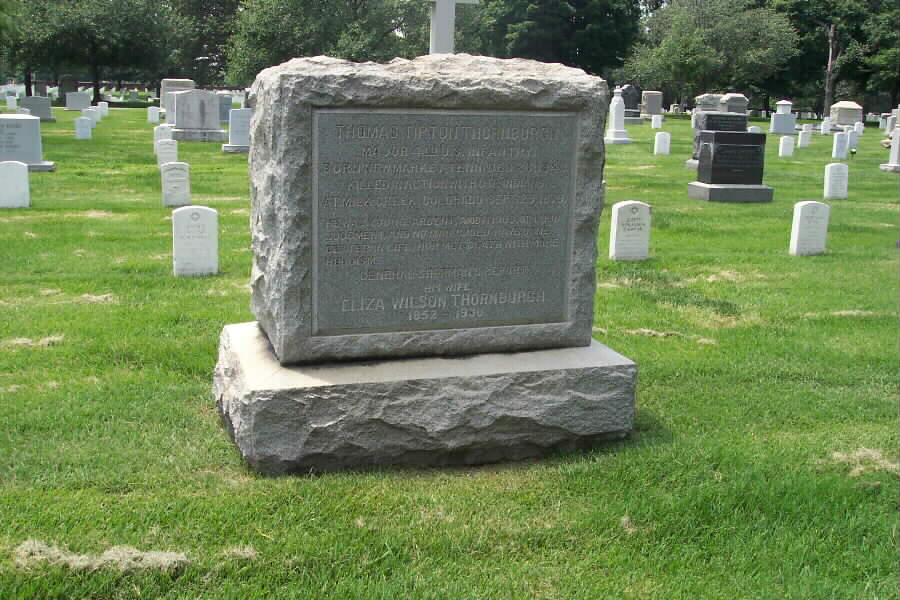“He was young, ardent, ambitious, of good
judgment and no man could have done
better in life nor met death with more heroism”
General Sherman’s Report
Thomas T. Thornburgh, soldier, born in Tennessee about 1843; died near White river agency, Wyoming, 29 September, 1879.
He was graduated at the United States Military Academy, and promoted Second Lieutenant in the 2nd Artillery in 1867.
At the opening of the civil war and prior to his admission to West Point he enlisted in the 6th east Tennessee volunteers in 1861, and passed rapidly through the grades of Private, Sergeant Major, Lieutenant, and Adjutant. He took part in the battle of Mill Spring, Morgan’s retreat to the Ohio, and of Stone River
As an officer of artillery he served in garrison in California (excepting a tour of duty at the artillery-school) until 1870, and as professor of military science at East Tennessee university till 1873, having been promoted First Lieutenant in April, 1870. In April, 1875, he was appointed paymaster with rank of Major, serving in that department until May, 1878, when he exchanged into the 4th United States infantry, with the same rank. He commanded the post of Fort Fred Steele, Wyoming, until 1879, when he was killed while in command of an expedition against the Ute Indians.
Thomas Tipton Thornburgh was born on December 26, 1843 at New Market, Jefferson County, Tennessee. He died on September 29, 1879 in Colorado.
Thomas Tipton Thornburgh, son of Montgomery and Olivia Ann (Dyer) Thornburgh, married Eliza Willson Clarke, daughter of Colonel Robert D. Clarke, 26 December 1870.
While leading a command of cavalry to rescue settlers under attack by Utes, Major Thomas T. Thornburgh and 13 of his soldiers was ambushed and massacred 29 September 1879, in an event that became known as “Meeker’s Plow Share Incident.”
Major Thornburgh’s body was sent to Omaha, Nebraska for burial. He was later disinterred and reburied in Section 3, Grave 1397, under a private memorial at Arlington National Cemetery. His wife, Eliza Wilson Thornburgh (1852-1930) is buried with him.
A monument in Colorado marks the location where the popular officer and his men fell. The town of Thornburgh in Keokuk County, Iowa was named to honor his memory and bravery.
Lieutenant Thomas Thornburgh was married to Miss Lida Clarke at Trinity Church. He had been a member of this church during his tour of military duty at Fort Omaha. His wife Lida and her parents, Colonel and Mrs. Robert Clarke of Fort Omaha, were also members.
In 1878, Thornburgh, now a Major, was transferred to Wyoming to take command of Fort Fred Steele. The following year, 1879, was a fateful one for the family. It started off with tragedy when little George Washington Thornburgh died at Fort Steele on March 5th. The family had not recovered from their grief when trouble began to flare at White River Indian Agency in western Colorado. Indian Agent Nathan C. Meeker, at this agency, was putting the pressure on the Northern Ute Indians to settle down and start farming. When Meeker finally plowed up the grassy field used by the Indians to pasture their hunting herds, the Indians rebelled.
Major Thornburgh rode south from Fort Steele to crush the uprising. At Milk Creek, near present-day Craig, Colorado, on September 29,1879, the Ute Indians under their chief, Captain Jack, ambushed the troops. Major Thornburgh was killed almost immediately. The troops were finally rescued and Major Thornburgh’s body was packed in mud and returned to Omaha for burial.
Rawlins, October 1, 1879
E.A. Hayt, commissioner of Indian affairs:
“Since the arrival of the mail from the White River agency, a special messenger has arrived and reports Major Thornburgh’s command having been attacked by Indians on Milk Creek, eight miles north of the [White River] agency and the Major and 13 soldiers killed, I fear that Agent Meeker and the employees are all massacred as the teams and wagons transferring Indian supplies from here have been destroyed by Indians. Signed, James France”
Rawlins – It is now reported that Agent Meeker and his family, and all the employees of the agency, have been murdered and the agency building destroyed, but this report lacks confirmation. Settlers from Snake and Bear Rivers are flocking in here for safety and considerable excitement prevails.
Colorado Springs Gazette 2 October 1879
Nathan Meeker was struggling with his job as Indian Agent at White River. Many of the Utes in his charge rebelled against his plans to change their way of life. Some of them fled the Agency to raid nearby farms. After the raids increased, Meeker sent out a plea for military help. His request was answered.
Major Thomas T. Thornburgh, a West Pointer, Civil War veteran from Tennessee, and a professor of military strategy, had been based at Fort Steele in Wyoming on scouting duty for more than a year. He led a command of 153 soldiers and 25 civilians toward the Ute Reservation, and agreed to ride alone to meet Meeker and two of the complaining Indian leaders. But when he reached Milk Creek, 25 miles north of White River, he found the creek dry. He ordered his troops to move some miles into the reservation where there was available water. Indian eyes were watching. Suddenly a gun was fired, then all the guns blazed. Within minutes, Major Thornburgh, and at least 11 of his troopers and teamsters lay dead, another 28 were wounded, and three-quarters of the horses and mules were killed. The trapped Army survivors found refuge behind wagons and piled up bodies of dead horses, and managed to hold off the warriors until relief troops arrived six days later.
THE UTES REVENGE
An Appeal ToTheTomahawl
An Indian Massacre at Milk River, Colorado
Colonel Thornburgh and a Number of His Men Killed
The Penalty of Bad Faith Visited Upon The Intruders
MILK RIVER, Colorado, September29, 1879 – Thornburgh’s command was attacked in a canyon at noon today, one mile south of here, on our march to the agency, and retreated in good order to the wagon train, where we are now entrenching ourselves.
4:40 P.M. Thornburgh was killed instantly during the retreat. Captain Payne was wounded in two places slightly. Lieutenant Paddock and Captain Grimes were also painfully wounded. Ten enlisted men and the wagon master, McKinstry, were killed and twenty-five men wounded. The command snow very well sheltered, bit and then are heard guns of new hostiles who have just arrived. Our mules and horses are getting it all around. The red devils fired the grass all around us to burn us out.
September 29 – 9 P.M. We are still holding our position. Every man is busy digging trenches and hauling out the dead animal’s fort he defense tomorrow. We expect to be attacked at daylight. Our courtier, Joe Rankin, has volunteered to carry dispatches to Rawlins. Mr. Gordon’s freight outfit of Indian supplies near us has been burned, also the cavalry wagons of Company F, Fifth Cavalry. About three-fourths of our horses and mules have been killed. Should reinforcements reach us in five days we can hold out very well with the ammunition?
Chicago, October 1 – Dispatches to General Sheridan corroborate the foregoing. Thornburgh’s command consisted of three companies of Cavalry. The Indians, who were several hundred in number, were of the Ute tribe and said to be well armed and very brave. Over five hundred soldiers are ordered to then rendezvous at Rawlins, and will reinforce the imperiled party as soon as possible.
Washington, October 1 – From the Indian Bureau it is ascertained that the following are among the causes which led to the fight at Milk River, Colorado. In June last an irruption of the miners upon the White River Ute’s’ Reservation caused ill-feeling among the Indians who wandered off from the reservation and committed a number of incendiary acts. On September8th, Agent Meeker reported that the Indians insisted upon his discontinuing the plowing of land which they wanted for a pasture. A plowman was fired on, when the agent called for a council which resulted in a reluctant consent to have the work proceed. On September 13 Meeker telegraphed that he had been assaulted by Chief Johnson and forced out of his house and asked the government for protection, which was ordered. Major Thornburgh’s command was bound thither when attacked. It is feared Meeker and all on the reservation are massacred.
Ogden, Utah, October 1 – Major Bryant, of the Fourteenth Infantry, with four companies, left here this afternoon for the relief of Major Thornburgh’s command.
Omaha, October 1 – It is believed here that Major Thornburgh, who is an experienced and cautious officer, fell into an ambuscade planned by the enemy. The military authorities are unanimous in the belief that the worst has now been told, for Lieutenant Payne strongly entrenched near the water is well provisioned and will further fortify himself by throwing up earthworks, which with the wagon train, will enable to hold his own until reinforcements appear, which will be soon. General Williams has consulted with General Crook, who is in Chicago, and ordering matters forward. General Merritt, at Fort D. A. Russell, Cheyenne, was telegraphed to and ordered to take command of the expedition. The message was carried by the operator who received it at the latter place to the General at his headquarters on horseback. General Merritt immediately began preparing forth expedition. At Camp Douglass and Salt Lake no time was lot, but everything was perfected at short notice. At Fort McPherson and Sanders the same activity prevailed. The Union Pacific railroad worked in harmony with the military, and troops are now en route for Rawlins, from which point succor will be sent out.
A special train of four cars of troops from Camp Douglass left Ogden at2 P.M. today for the scene of the outbreak. The train was under orders to make fast time. Three hundred men and six hundred horses left Cheyenne today for Rawlins. One company left Fort Sanders, and two companies of cavalry left Fort McPherson today for Fort Steele, the latter had horses, baggage, etc, with them. The troops have been ordered forward from Forts Fetterman and Robinson, and will leave for the seat of war as soon as they can reach the railroad. General Merritt, to whom the command of the expedition if given, is one of the best Indian fighters in the country. This afternoon he telegraphed General Williams that he would be ready to start tomorrow morning with a force of nearly tt0 men. As animals and provisions are plenty, the march will be forced and relief will soon reach those in peril. Major Thornburgh’s body has not been recovered, but lies in front of his command and cannot be procured. He was a very powerful man, fully six feet two inches in height, active and muscular, a good shot and a daring horseman. He leaves a wife and two children who are at Fort Steele.
MASSACRED BY UTES
An appalling Castrophe Overtakes a Body of Troops
Marching to Relieve the White River Ute Agency in Colorado
Major Thomas T. Thornburgh and Thirteen Soldiers Slaughtered
Captain Payne, Lieutenant Paddock and Dr. Grimes Severely Wounded
Thirty-five Soldiers and Teamsters Also More or Less Hurt
The Bloody Deed the work of Rebellious Ute Indians
Milk River, Colorado, the Scene of the Carnage
Major Thornburgh Presumed to Have Been Led Into Ambush
The Command Now Entirely Surrounded by the Merciless Foe
General Merritt on His Way to the Relief of the Beleaguered Command
With Large Force of Cavalry and Infantry – Other Details
OMAHA, Nebraska, October 1, 1879 –Major Thornburgh’s command, which was out after the hostile Ute Indians, was suddenly corralled and attacked by several hundred Ute Indians near Milk River, in the vicinity of the Ute Reservation in Colorado. Major Thornburgh was killed, and a large number of men wounded and the command entirely surrounded.
In the following dispatches, received this morning at 4 o’clock by General Williams of this city, Assistant Adjutant General of the Department of the Platte:
Milk River, Colorado, September 29, 1879 – Via Rawlins – To The Adjutant General, Department of the Platte, Omaha Barracks, Nebraska: This command, composed of three companies of cavalry, met a mile south of Milk River by several hundred Ute Indians, who attacked and drove us to the wagon train, from which we had parted, with great loss. It becomes my painful duty to announce the death of Major Thornburgh, who fell in harness; the painful but not serious wounding of Lieutenant Paddock and Dr. Grimes and the killing of 10enlisted men and Wagon master McKinstry, with the wounding of about twenty-five men and teamsters. I am now corralled near water, with about three-quarters of our animals killed, after a desperate fight since 12o’clock P.M. We hold our position at this hour; I have strengthened it during the night, and believe that we can hold until reinforcements each us, if they are hurried through. Officers and men behaved with the greatest gallantry. I am slightly wounded in two places, Payne, Commanding.
Fort Steele, Wyoming Territory, September 30, 1879 – Adjutant General: The following dispatches have just been received by me. Bisbee.
Milk River, via Rawlins, Colorado: September 30, 1879 – Captain Bisbee, Fort Steele: Paddock is painfully, but not dangerously wounded in the hips; he is weak from the loss of blood, but cheerful and in good spirits. Captain Lamson is all right also. Walt Payne is wounded slightly twice. My horse was shot while holding the bridle. We are working faithfully to throw up fortifications for tomorrow. Cherry.
Milk River, September 29, 1879, Via Rawlins, repeated from Fort Steele. To Captain Bisbee, Fourth Infantry, Fort Steele, Wyoming Territory: Major Thornburgh was killed instantly today, while directing the movements of the troops. A more perfect gentleman and gallant solder never lived. Accept my condolence. We hope to recover the body, which lies only about 500 yards from here. Cherry, Adjutant.
Milk River, Colorado, October 1, 1879 – Bisbee, Fort Steele: The existence of the command depends solely on the haste with which reinforcements are gotten here. I am entrenched here, as Payne has directed me simply to hold my camp and not advance. Price.
Fort Steele, Wyoming Territory, September 30, 1879: To the Adjutant General of the Department of the Platte: Ten wagons loaded with rations for men and animals of the Ute expedition are at Rawlins, intending to start this morning. Shall hold them until reinforcements arrive. Bisbee, Commanding Post.
General Williams, in receipt of the above dispatches, immediately ordered reinforcements by telegraph of two companies of cavalry from Fort Gibson, every man that could be spared from Forts D. A. Russell and Sanders, Company D, Third Cavalry, from Fort Laramie, and a company of cavalry from Fort Fetterman; also, troops from Fort McPherson, all to be forwarded to railroad as soon as possible. A large number of troops will reach Rawlins, on the Union Pacific, by rail tomorrow, and proceed thence by forced marches to the distressed command, which is corralled a rough and dangerous country.
Thomas T. Thornburgh
Thornburgh, Thomas T., soldier, born in Tennessee about 1843; died near White river agency, Wyoming, 29 September, 1879.
He was graduated at the United States Military Academy, and promoted Second Lieutenant in the 2nd United States Artillery in 1867. At the opening of the Civil War and prior to his admission to West Point he enlisted in the 6th east Tennessee volunteers in 1861, and passed rapidly through the grades of Private, Sergeant Major, Lieutenant, and Adjutant. He took part in the battle of Mill Spring, Morgan’s retreat to the Ohio, and of Stone River.
As an officer of artillery he served in garrison in California (excepting a tour of duty at the artillery-school) until 1870, and as professor of military science at East Tennessee University till 1873, having been promoted First lieutenant in April, 1870. In April, 1875, he was appointed Paymaster with rank of Major, serving in that department until May, 1878, when he exchanged into the 4th United States Infantry, with the same rank. He commanded the post of Fort Fred Steele, Wyoming, until 1879, when he was killed while in command of an expedition against the Ute Indians.
His son, Robert Montgomery Thornburgh, Colonel, United States Army, is also buried in Arlington National Cemetery, as is his nephew, Thomas Tipton Thornburgh, Colonel, United States Army, who was killed while on an air mission in World War II.
THORNBURGH, T T
- MAJOR 4TH US INF
- VETERAN SERVICE DATES: Unknown
- DATE OF DEATH: 09/29/1879
- DATE OF INTERMENT: Unknown
- BURIED AT: SITE 1397
- ARLINGTON NATIONAL CEMETERY
THORNBURGH, THOMAS TIPTON W/O THOMAS TIPTON
- DATE OF DEATH: 09/29/1879
- DATE OF INTERMENT: 10/13/1903
- BURIED AT: SECTION S SITE ;PT 1397
- ARLINGTON NATIONAL CEMETERY
- MAJOR 4TH US INF
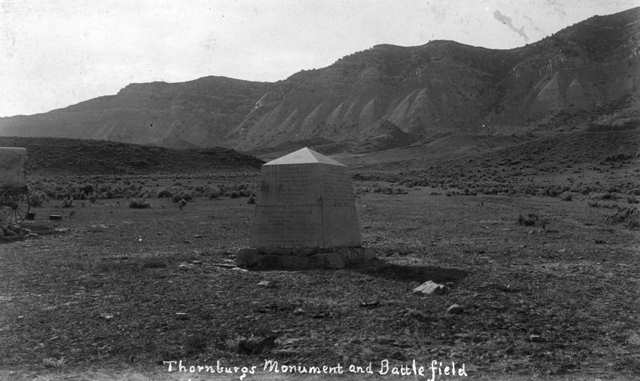
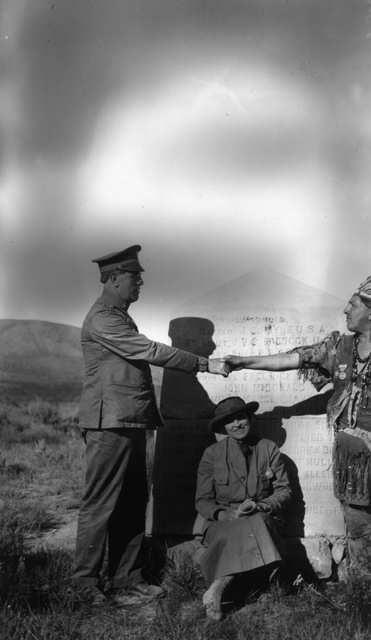
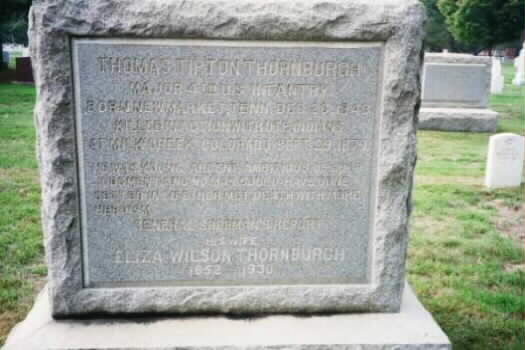
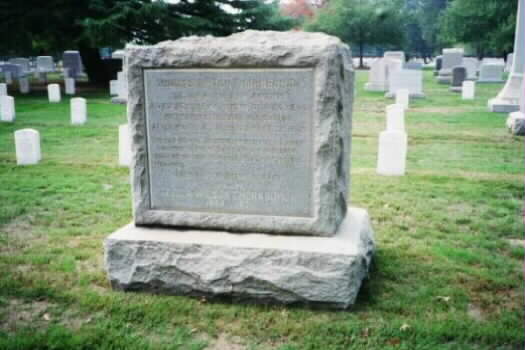
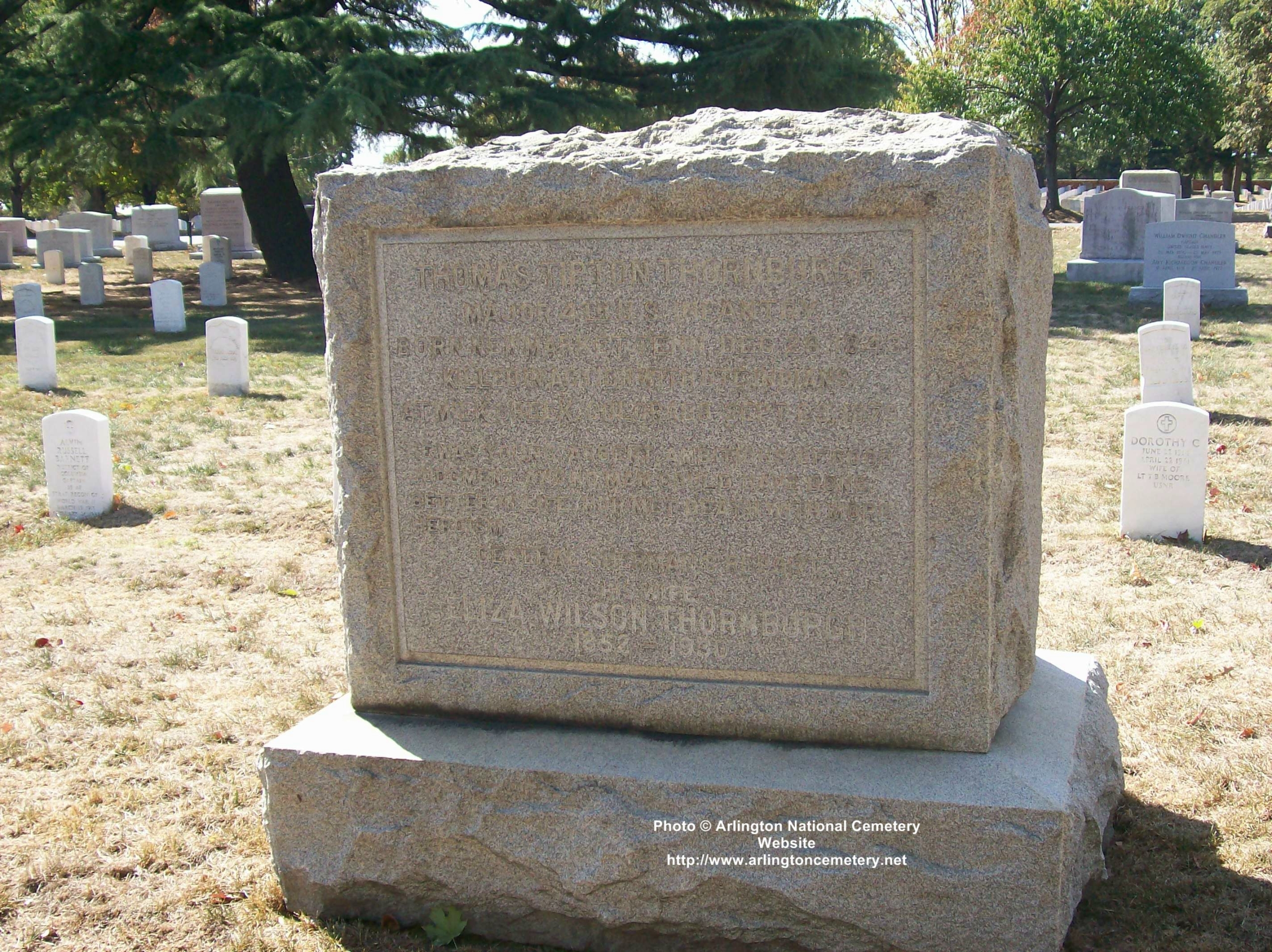
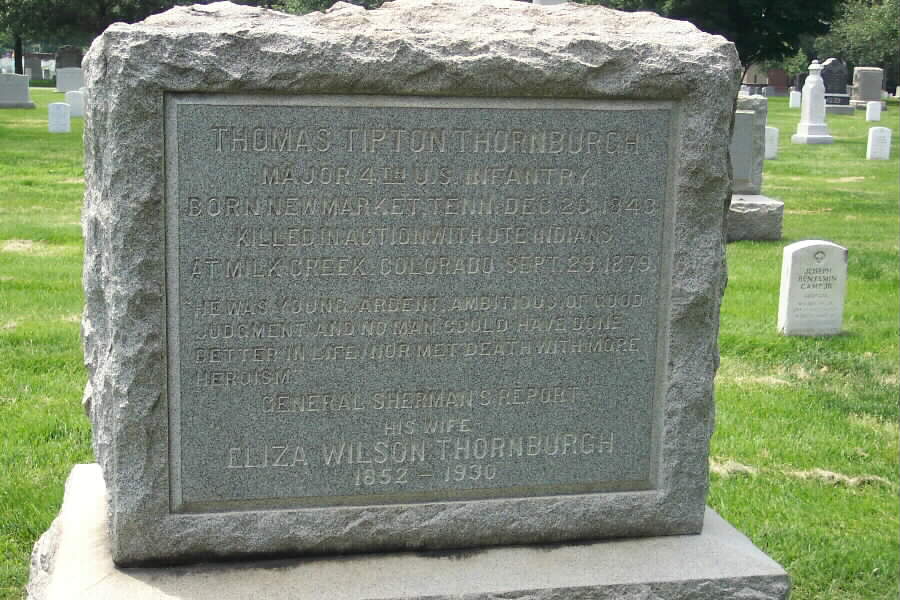
Michael Robert Patterson was born in Arlington and is the son of a former officer of the US Army. So it was no wonder that sooner or later his interests drew him to American history and especially to American military history. Many of his articles can be found on renowned portals like the New York Times, Washingtonpost or Wikipedia.
Reviewed by: Michael Howard

